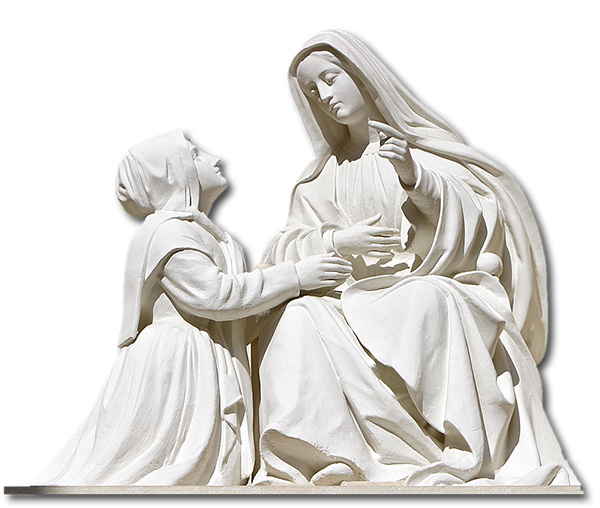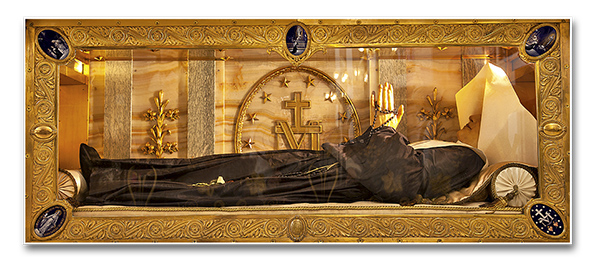Only after her death were the veils of this nun’s heroic humility lifted. Her silence kept her great mission of seer and messenger of the Queen of Heaven hidden from the eyes of the world.
At the close of 1858, tidings spread throughout Paris about the apparitions of Our Lady to a peasant girl from the Pyrenees, in Lourdes, a locale of little importance within French territory. Stories were shared of extraordinary cures obtained after using the water of the miraculous spring from the Grotto of Massabielle and, above all, everyone was abuzz about the famous young seer, Bernadette Soubirous, whose unpretentiousness and resolute faith had sparked the admiration of the people, who promptly venerated her as a saint.
Soon spreading throughout the French capital, the news reached the ears of the Daughters of Charity of St. Vincent de Paul, who served the elderly in the Hospice of Enghien. An animated conversation ensued, in which a usually discreet sister showed vehement enthusiasm, letting an exclamation escape her: “She is the same one!” 1 Unable to fathom the meaning of these words, the sisters glanced at one another, perplexed, and carried on their conversation, as if nothing had happened.
“A mystical rainbow between Rue du Bac and Lourdes”
In 1830, a novice from the Motherhouse of the Company of the Daughters of Charity, located on the Rue du Bac in Paris, had also been the object of apparitions of Our Lady, which had become famous worldwide. In addition to making important revelations about the future of the Congregation and France, the Mother of God entrusted the seer with the mission of having a medal struck through which she would shower abundant graces upon the world. The distribution of the first issue of medals was set in motion by a cholera epidemic that ravaged Paris, and the cures attributed to the use of this medal—not surprisingly called Miraculous by the people—were so numerous and astounding that before long it had already been disseminated throughout several countries.
The name of the seer, however, remained unknown, even among the sisters of her community. Only after her death was it revealed to be the silent, diligent and ever good-natured Sister Catherine Labouré! Her clear blue and serene eyes shone with joy in hearing for the first time of the recent apparitions of Lourdes, an echo of those that had taken place on the Rue du Bac. It was another light that had appeared along the same path of mercy traced by the Queen of Heaven to lead humanity to a new era of Marian graces.
There was no doubt that she was the “same one.” To the Parisian novice, the Blessed Virgin taught the formula for invoking her: “O Mary conceived without sin.” To Bernadette, she presented herself with the words: “I am the Immaculate Conception.” Overflowing with joy, Sister Catherine conceived a profound admiration for the new seer, although she never met her. Little did she know that in Lourdes, Bernadette was wearing the Miraculous Medal around her neck when she saw the Mother of God, and that she probably fostered noble sentiments of veneration in her heart for the unknown seer of the Virgin of the Medal… From the supernatural perspective, there was a close spiritual union between the two saints, forming “a type of mystical rainbow between Rue du Bac and Lourdes.” 2
St. Bernadette demonstrated heroic humility, redirecting all honours and praises that the people paid her to the Queen of Heaven. St. Catherine practiced the same humility in a different way: dedicating herself to the lowliest tasks in the Hospice of Enghein, where she served the elderly and poor for more than forty years.
Childhood enveloped by faith and seriousness
When Catherine was born on May 2, 1806, France was still ailing from the wounds of irreligion opened by the Revolution of 1789. The tiny Burgundian village of Fain-lès-Moutiers where the Labouré family resided had no priest. To baptize the newborn, the pastor of the neighbouring village had to be called. Despite the generalized religious negligence of the time, to which her father, Pierre Labouré, was not immune, the faith of Catherine and her nine siblings was protected and fortified thanks to the care of their mother, Madeleine Gontard, whose chief concern in educating her children was to instil in them boundless confidence in the Blessed Virgin.
Zoé, as our saint was known before she entered religious life, lived her first years under sunny blue skies, amid the joys of a childhood suffused in the sweet fragrance of innocence. She acquired a liking for prayer from an early age and readily abandoned childish games whenever her mother called her to join her in prayer before the statue of Our Lady enthroned in the home.
Gifted with a precocious sense of responsibility and seriousness, Zoé was quick to perceive her mother’s fatigue in the arduous tasks of housekeeping, and promptly stepped in to help. Before turning eight, she already knew how to sew, milk the cows, prepare the soup and sweep the floor. The conviction that motivated her to joyfully embrace the most monotonous daily chores, both at home during her childhood and adolescence, as well as during the four decades she would later spend in the Hospice of Enghein, was summed up in her own simple but luminous words, “One is never bored with doing the will of God.” 3

A transforming grace
At age nine, little Zoé’s horizons were darkened by tragedy: in October of 1815 her mother died. The girl wept bitterly as she looked upon her lifeless body, but she soon remembered her, whom her own mother had taught her to turn to in moments of affliction. After recovering from the initial shock, she went to the statue of Our Lady before which she had so often prayed with her mother. Resolutely, she climbed up on a chair to reach the statue and embraced it, exclaiming between sobs: “From now on, you will be my Mother!” 4 The Queen of Heaven responded immediately. The defenceless girl, who had come to her in tears, went away strengthened and ready to confront all tribulations. It was the last time in her life that she cried, for the virtue of fortitude accompanied her in a crescendo until the end of her days.
In 1871, when she was a 65-year-old religious, the revolutionary uprising of the Commune of Paris afforded several occasions for her to heroically manifest this virtue. One day, for example, she decided to go to the headquarters of the insurgents to defend her superior, against whom an order for detention had been issued. She expressed her arguments so vigorously before the almost sixty commune members present that she came out victorious. Impressed, the revolutionaries treated her with marked deference; they even asked her to testify at the trial of a woman prisoner, accepting her witness in favour of the defendant as the last word in the case.
A corollary of this grace of fortitude received during her childhood was the constancy of soul with which she endured her confessor’s habitual signs of impatience and incredulity when, by order of Our Lady, she recounted her visions to him. A few months before her death, she confided to the superior that this attitude of the priest had been a veritable martyrdom for her. And with the fortitude of the martyrs she endured this silent oblation that had been foretold by the Blessed Virgin: “My daughter, the Good God wants to entrust you with a mission. You will have many difficulties, but you will be able to overcome them, remembering that you do so for His glory. You will know how to discern what comes from God. You will be tormented until you tell it to the one responsible for guiding you. You will be contradicted. But you will have grace. Do not fear. Say everything with certainty and simplicity. Have confidence.” 5
A true daughter of St. Vincent de Paul
“You will be happy to come to me. God has plans for you.” 6 At about 14 years of age, in a dream, Catherine heard these words addressed to her by an unknown priest whose penetrating and limpid gaze remained engraved in her memory. Some years later, visiting a house of the Daughters of Charity, she saw a portrait of the Founder of the Congregation, St. Vincent de Paul, recognizing him as the priest of her dream. Thus, the vocation to which she had so often felt attracted now became clear to her: she was to be a daughter of St. Vincent!
However, on her 21st birthday, May 2, 1827, when she announced her decision at home, her father was decidedly opposed. After trying in vain to dissuade her from embracing the religious life by arguments, he sent her to Paris to work in the restaurant of one of her brothers, imagining that she would eventually find a good match and get married.
However, working in that place, frequented by crude and often indecent working men, only served to strengthen the spotless purity of the young woman. Out of love for her vocation she comported herself as a true Daughter of Charity, perfectly fulfilling the recommendations of the Founder to his spiritual daughters, such as: “If from [cloistered] religious is required one degree of perfection, two should be demanded of the Daughters of Charity.” 7
Catherine desired only to embrace this daring goal entirely, and she persevered in her resolution until she overcame her father’s obstinacy. “If we are truly mindful of the small things, we will do great things,” 8 she wrote, decades later, upon completing a period of spiritual exercises.
Confidence and simplicity of an innocent soul
Finally, on April 21, 1830, Catherine arrived at the Convent of the Rue du Bac. The Council of Superiors soon discerned in her an authentic vocation: “She is 23 years of age and is very suited to our community: pious, of good character, strong temperament, suited to work and very joyful,” 9 was the evaluation written about her. Furthermore, she was a genuine peasant girl, as was the preference of St. Vincent, who took the good qualities of a villager as the basis for drawing up the ideal of virtue for the Daughters of Charity. Whether in community life, the service of the poor, or even during the supernatural manifestations which she received, Sister Catherine always shone in one of the virtues most beloved of her holy Founder: simplicity of heart.
“The peasant’s spirit is very simple: no trace of deception or duplicity in their words; they are neither stubborn nor attached to their opinions. […] My daughters, this is how the Daughters of Charity should be, and you will know that you have achieved this when you are simple, steadfast, submissive to the opinion of others and candid in your speech, and your hearts do not think one thing while your mouths say another.” 10 This ideal sketched by St. Vincent, almost two centuries later, found its perfect realization in the soul of this chosen daughter.
During the week after her arrival at the convent, the heart of St. Vincent appeared to her on three consecutive days, foretelling the imminent disasters that were to befall France, promising that the two Congregations he had founded would not perish. The happy novice was also privileged with a vision of Christ present in the Sacred Host, during the entire time of her novitiate, “except when I doubted,” 11 she confessed.
Imbued with faith that moves mountains and draws down God’s benevolence, Catherine did not hesitate to ask for more: she wanted to see Our Lady. On the eve of the feast of her Founder, which was commemorated on July 19 at that time, she consigned her desire in a short prayer and went to sleep filled with hope: “I lay down convinced that I would see my good Mother that very night. I had long desired to see her.” 12 And she was generously heeded, not only “that very night,” but also in two subsequent apparitions, in November and December of 1830.
With the passing of the years, her unlimited and filial confidence in three main pillars of devotion intensified to the point where shortly before dying, she could not hide her amazement when her superior asked her if she feared death: “Why would I fear going to see Our Lord, His Mother and St. Vincent?” 13

“Our Lady made a good choice”
St. Catherine never revealed the secret of being the seer and messenger of the apparitions of the Miraculous Medal. Nevertheless, many noticed that she was a soul especially chosen by the Queen of Heaven because of her outstanding love of God which was not only affective—her ardent piety was unequalled—but also effective, as one of her contemporaries testified: “She carried out actions that were ordinary in themselves, in an extraordinary manner.” 14 There was something indefinable in her which was both discreet and sublime.
Her sanctity was the chief safeguard of her secret. To the sisters who dared to openly question her on the matter, she responded with absolute silence—a silence born of humility, neither taciturn nor aloof, but rather a sacral silence that inspired veneration.
After her death, when the name of the seer of the Rue du Bac was announced to the Daughters of Charity, their reaction was more one of admiration than surprise. It was not difficult for them to associate this exemplary sister with the already somewhat mythical figure of the anonymous seer. They were awed at the excellence of her humility, which maintained her anonymity while she exercised a mission of universal scale.
Perhaps at that moment the sisters recalled a candid saying of the children of the orphanage administered by the Daughters of Charity. When they saw Sister Catherine Labouré pass by, they would say to each other, “Our Lady made a good choice.” 15 Had these words, which proved so true, been merely the fruit of the children’s imagination, or had God, once again in history, revealed to little ones mysteries hidden from the wise and learned?
Nevertheless, more brilliant than her heroic silence is the lesson of filial confidence that St. Catherine displayed in the Mother who never abandons. “Confidence is always rewarded in this way. Asking with confidence, one receives more, with more certainty and more abundantly. Confidence opens for us the Wise and Immaculate Heart of Mary.” 16 ◊
Notes
1 LAURENTIN, René. Vie de Catherine Labouré. Paris: Desclée de Brouwer, 1980, p.197.
2 CORRÊA DE OLIVEIRA, Plinio. Speech. São Paulo, Nov. 12, 1980.
3 ST. CATHERINE LABOURÉ, apud LAURENTIN, op. cit., p.377.
4 CLÁ DIAS, EP, João Scognamiglio. The Miraculous Medal. Its History and Celestial Promises. São Paulo: Takano, 2001, p.7.
5 LAURENTIN, op. cit., p.85.
6 Idem, p.40.
7 ST. VINCENT DE PAUL. Correspondence, Entretiens, Documents, apud HERRERA, CM, José; PARDO, CM, Veremundo. San Vicente de Paul. Biografía y selección de escritos. 2.ed. Madrid: BAC, 1955, p.271.
8 ST. CATHERINE LABOURÉ, apud LAURENTIN, op. cit., p.156.
9 LAURENTIN, op. cit., p.50.
10 ST. VINCENT DE PAUL, op. cit., p.260.
11 ST. CATHERINE LABOURÉ, apud LAURENTIN, op. cit., p.78.
12 Idem, p.81.
13 Idem, p.289.
14 LAURENTIN, op. cit., p.375.
15 BERNET, Anne. La vie cachée de Catherine Labouré. Mesnil-sur-l’Estrée: Perrin, 2001, p.225.
16 CORRÊA DE OLIVEIRA, op. cit.







